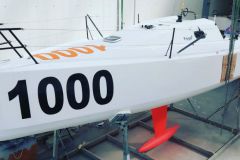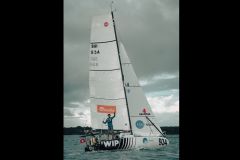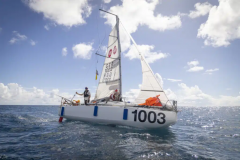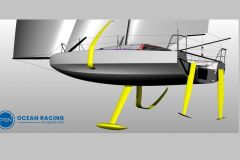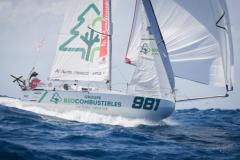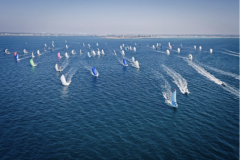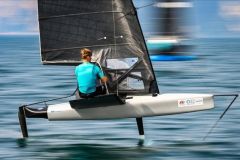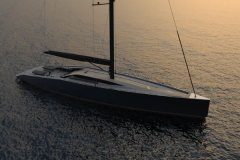Thomas Tison is a naval architect who doesn't hesitate to step outside the box. Trained at the America's Cup, among other things, he has the ability to read the gauges and find out how best to interpret them. And when he read the Mini 6.50's, he realized that it imposed a "hull length of 6.50 m". Why not then add a protrusion towards the back, just like the bowsprit is on the front?
A 1 m rear gantry crane
With this idea in mind, he designed a rear portico on which the rudder is installed, so that it is one metre off the hull. This project works because this sailboat has the will to fly on foils. It wouldn't really perform well for a sailboat that remains archimedean. This one will fly on 2 very marked V foils in front and a rudder with an adjustable bearing surface. And the greater the distance between the front and rear foils, the more stable the flight. Hence the idea of moving the rear load-bearing plane as far back as possible.
For very short sea conditions or when the skipper is asleep, the foils can be fully retracted, limiting drag. The scow-shaped hull will then take over to allow the boat to perform well.

Well thought-out architecture
Contacted on the phone, Thomas Tison explains: " The further the rudder is from the keel, the more you can reduce its surface area. The smaller rudder blade at the end of the gantry has less drag. To limit the impact of weight, the gantry is made entirely of Nomex carbon. He only weighs 3.5 kg! I chose a scow hull shape because on a small boat, the developed structural weight of the hull does not have much influence on the total weight, compared to the skipper who already weighs almost 10% of the boat's weight. ?
What does the Mini gauge think?
It remains to be seen how the gauges will react? ? When the gauge was changed and the maximum width allowed increased, I contacted the people in charge of the gauge to submit a project to them. It took them more than 2 months to tell me that it was not accepted before changing the gauge. This time, I go ahead and interpret the gauge without giving them the time to modify it to forbid my project! The Mini has always been an experimental laboratory in which one is pushed to go outside the box. There's no ban. And as my project should result in a yacht that is not less safe, but is faster and more stable, I don't see why the gauge would forbid it? ?
Any ideas that we can take this one step further?
Today the gantry protrudes 1m behind the boat, but why not make it much bigger? ? I don't think the added weight on the back won't change the behaviour. With one meter, I think we're in a good compromise. But if this prototype is successful, no doubt others will push the research with much larger sizes. We could then see much more extreme boats later on.. ?
It sails in the spring of 2020
The hull of this future Mini is already built as well as the rear gantry. All that remains now is to assemble all the elements before seeing the yacht sail in the spring of 2020. ? This is a European project that receives grants to test composite construction methods. So we're going to carry out a test campaign with sensors all over the boat before handing her over to a skipper for the next Mini Transat 2021 ?

 /
/ 





